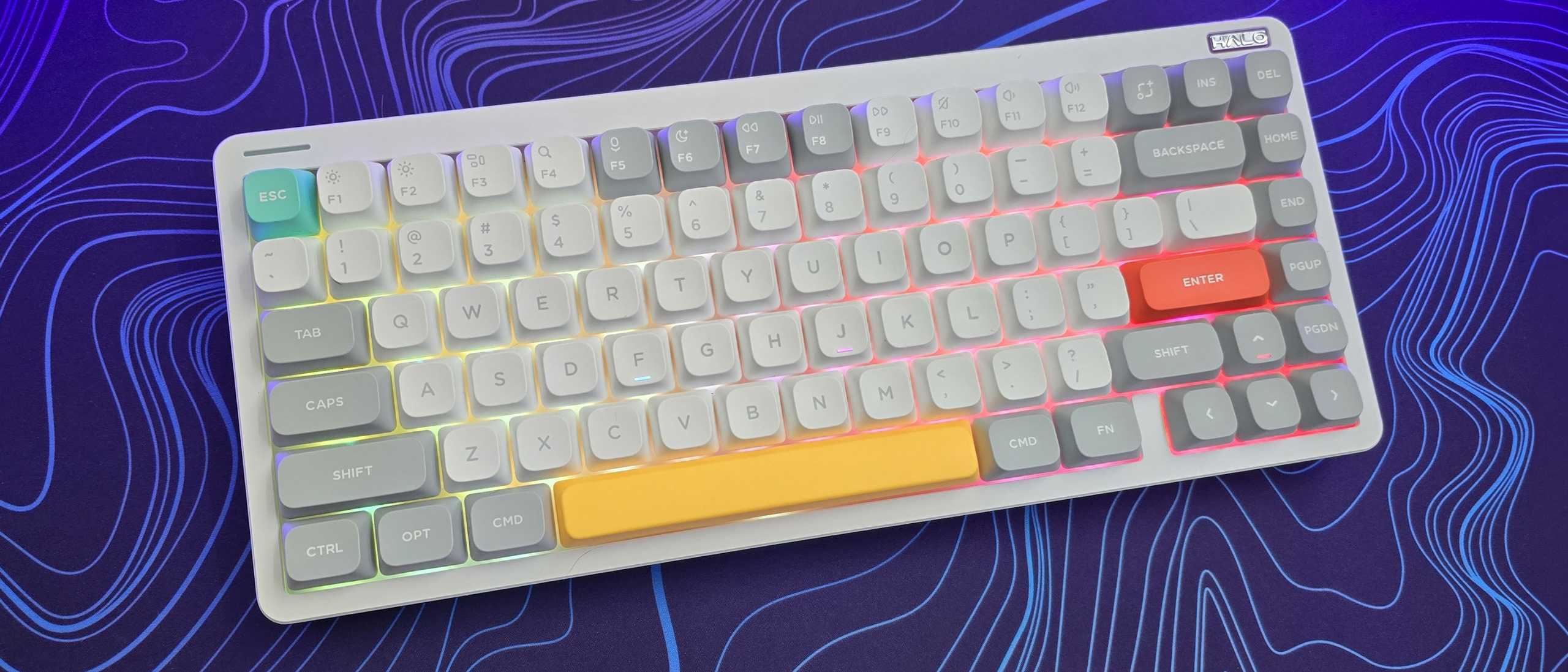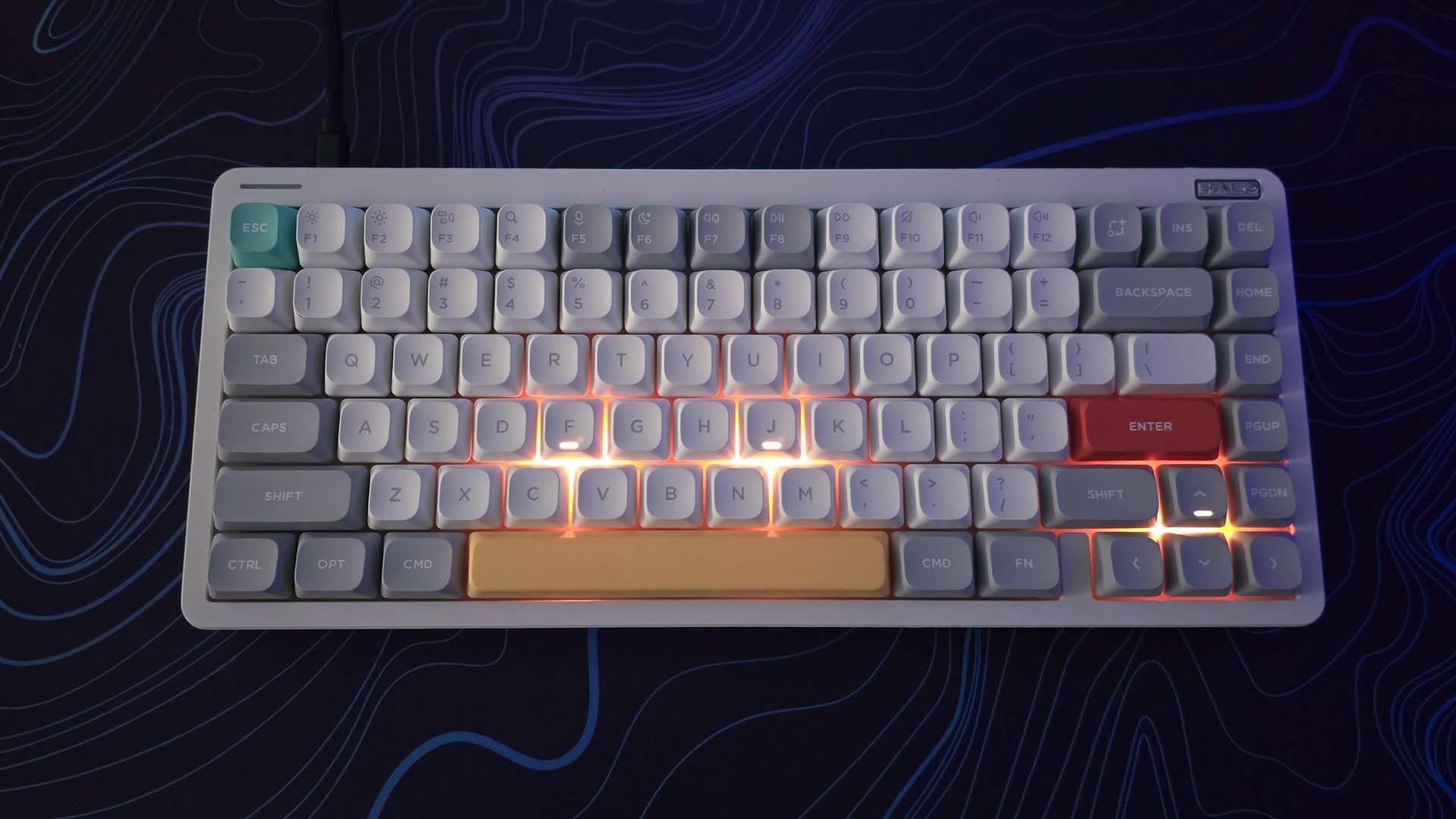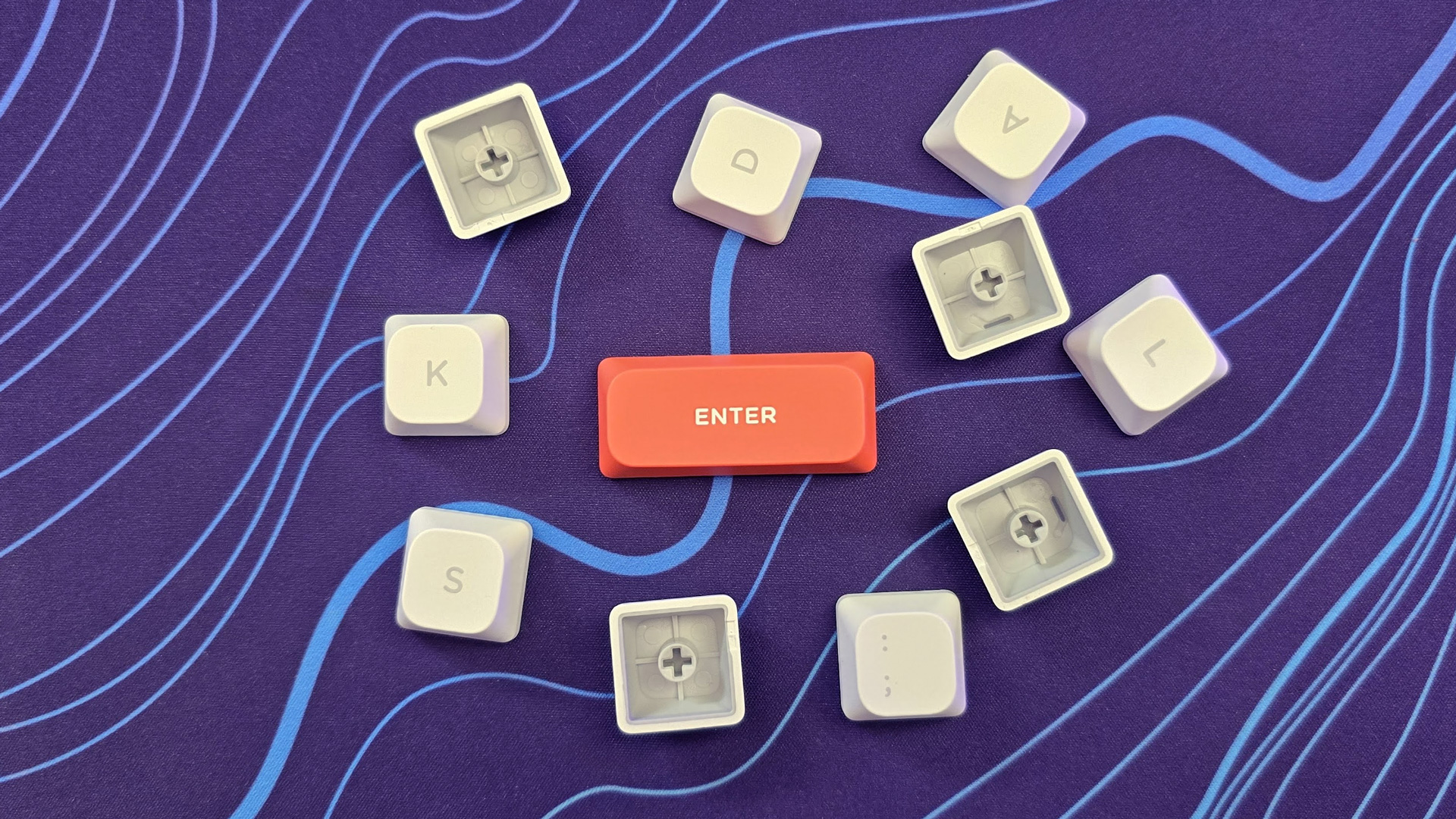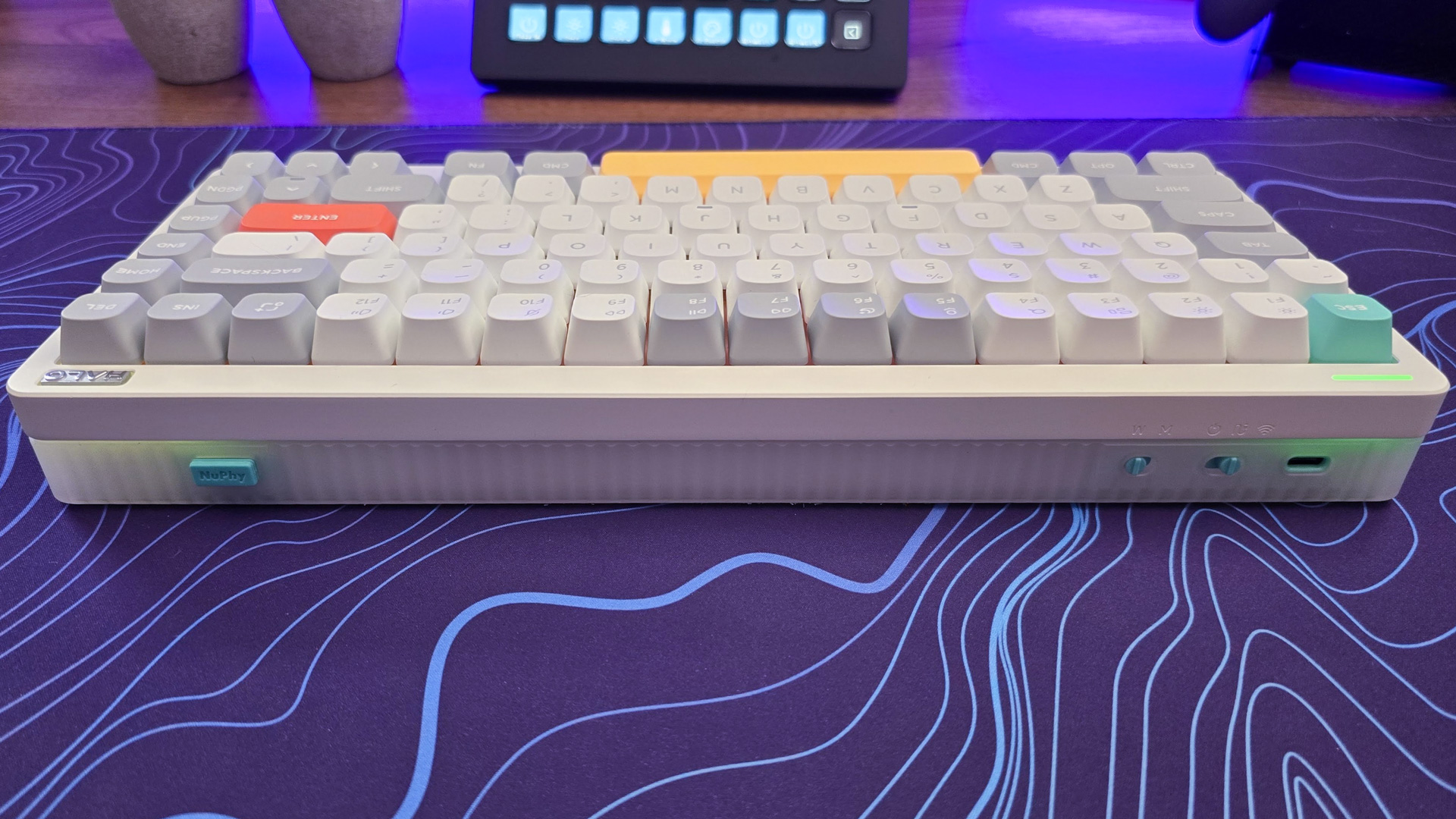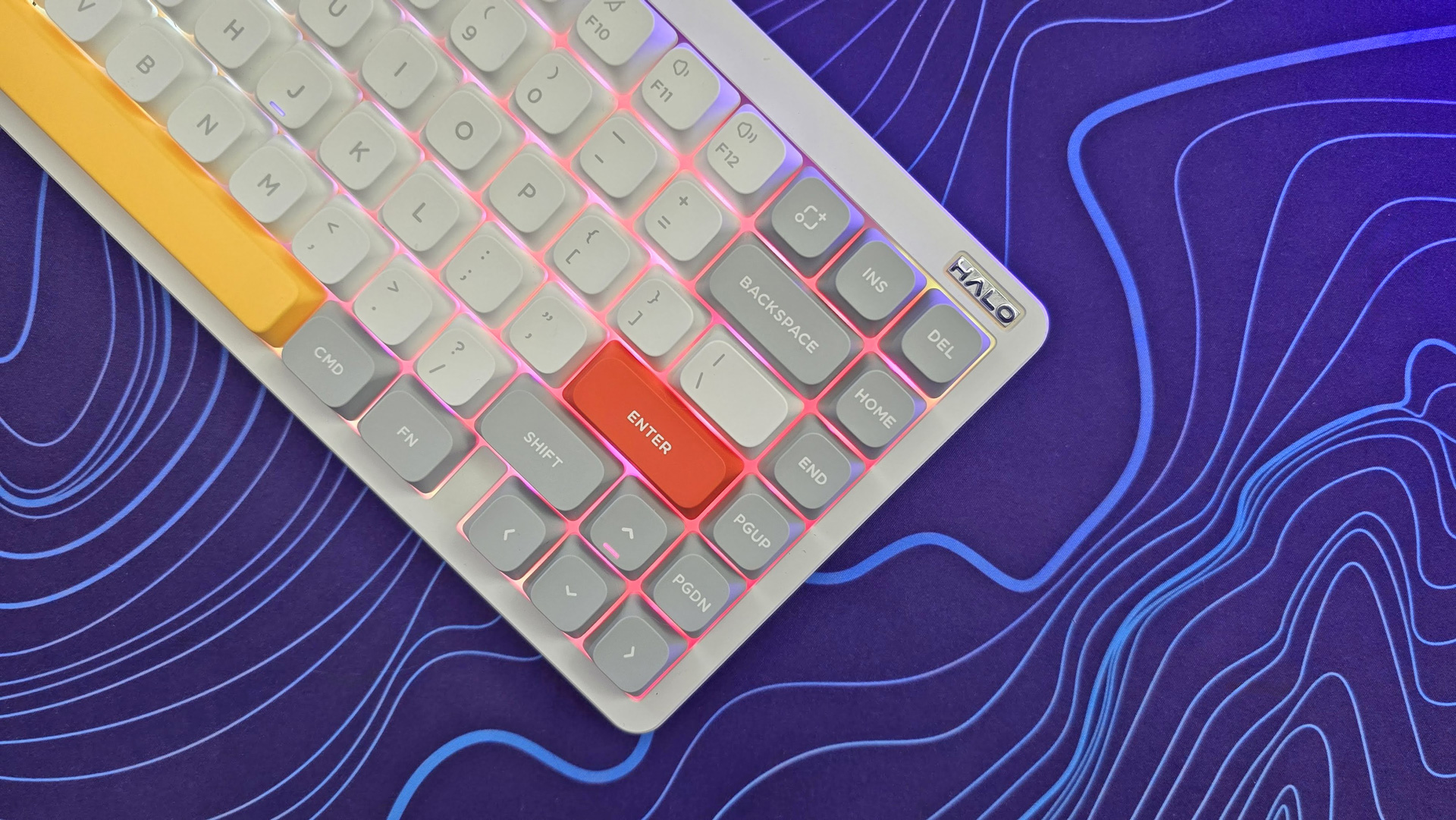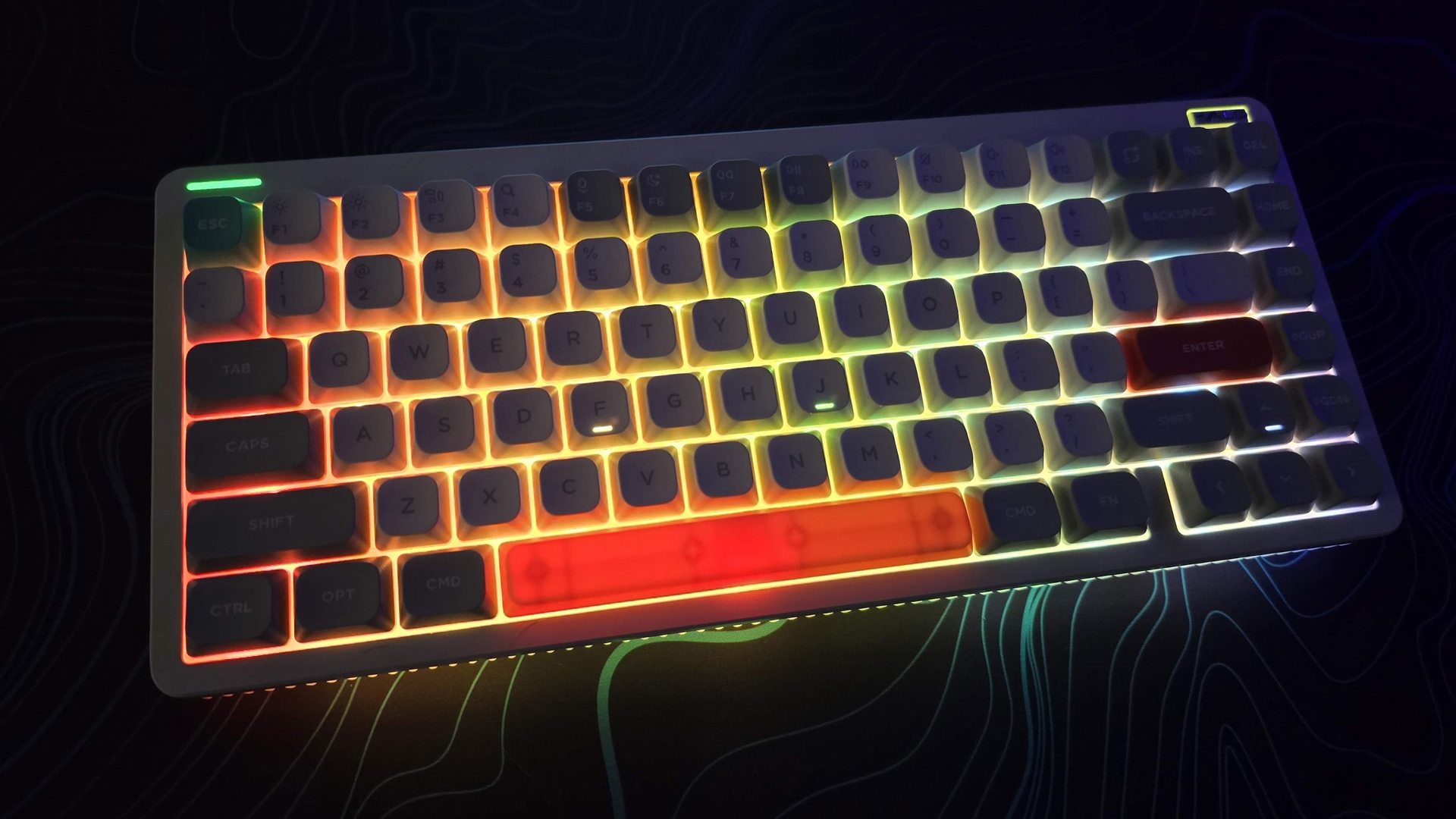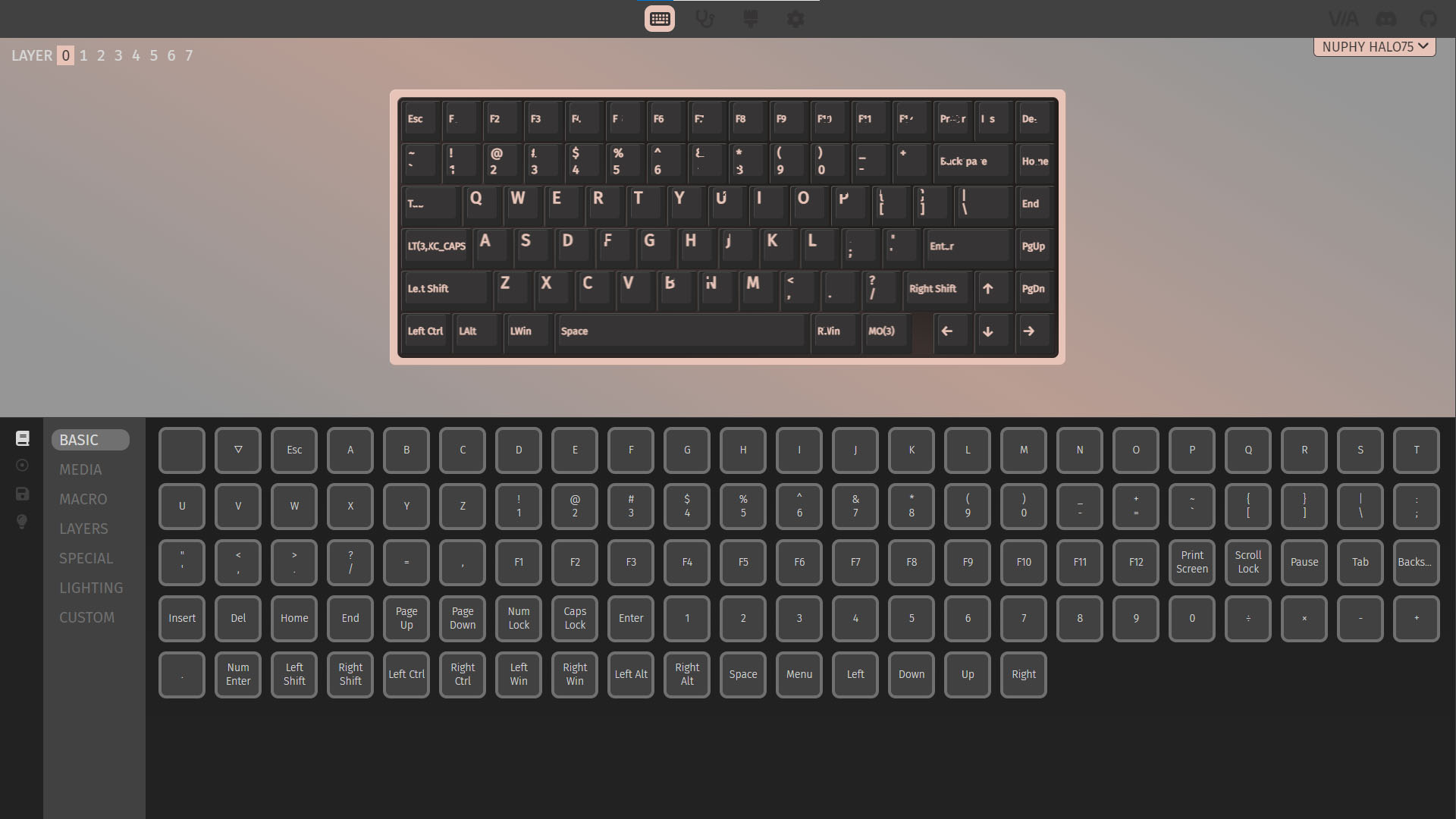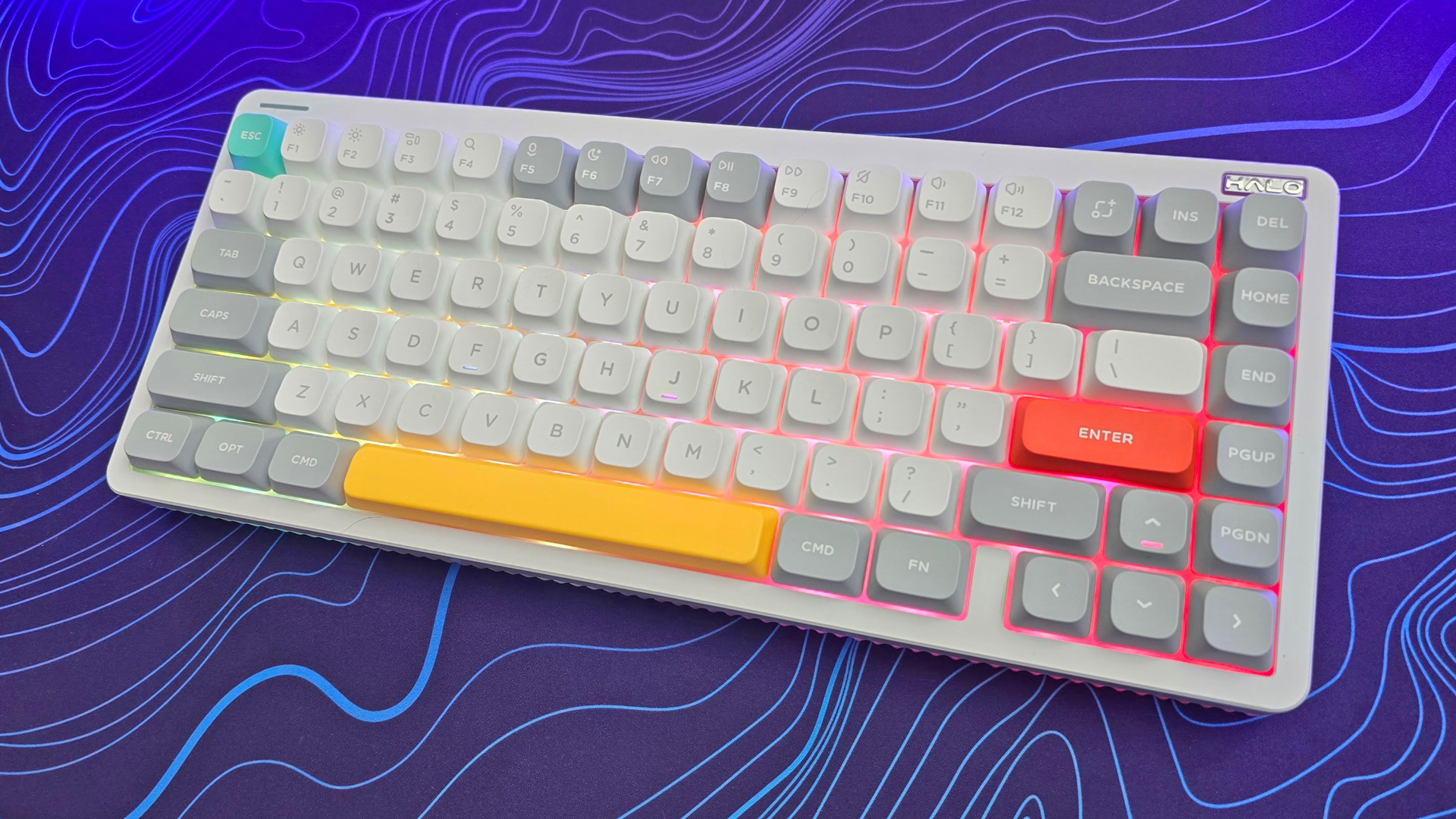Tom's Hardware Verdict
The Halo75 V2 is attractive and it feels great for both typing and gaming — and it's a very good deal.
Pros
- +
Excellent typing experience
- +
High speed wireless for gaming
- +
Highly programmable
- +
RGB showcase
- +
Built to an enthusiast’s standard
Cons
- -
Lemon switches alter RGB
- -
Massive range in battery life
- -
Halo light doesn’t provide even lighting
Why you can trust Tom's Hardware
It has been nearly two years since Nuphy released the Halo75, the first in its line of full-height enthusiast mechanical keyboards. We now have the Halo75 V2 in hand and it packs some big changes, nearly all for the better. At only $130, it’s vying for a spot in our list of the Best Mechanical Keyboards and — spoiler alert — it might just earn it.
Halo75 V2 Specs
| Switches | Nuphy Mint, Lemon, Raspberry, Cherry MX Silent Red |
| Lighting | Per-key RGB |
| Onboard Storage | 8 Profiles (Layers) |
| Media Keys | Secondary Layer |
| Connectivity | USB Type-A, Bluetooth 5.0, 2.4GHz |
| Cable | Braided, coiled USB Type-C to Type-A |
| Additional Ports | None |
| Keycaps | Doubleshot PBT plastic |
| Software | VIA |
| Materials | Aluminum top, ABS bottom, polycarbonate plate |
| Dimensions (LxWxH) | 5.31 x 12.6 x 0.83 (front)/1.29 (back) inches |
| Weight | 2.47 pounds |
Design of the Halo75 V2
The Nuphy Halo75 V2 is an enthusiast grade compact mechanical keyboard. It features a 75-percent layout, which means that it’s one to two inches smaller than a tenkeyless (which is 80-percent) but still has a full function row, arrow keys, and a column of navigation and editing buttons. Nuphy also has a 96-key version of this keyboard, which is available to pre-order for just $10 more than this keyboard's $130 asking price.
The Halo75 V2 is available in black or white, and is exceptionally stylish with a lean toward minimalism. Both colors maintain their theme: the white versions use white and gray keys, while black uses black and dark gray. Both versions come with colorful accent keys pre-installed: Escape is teal, Enter is red, and the spacebar is yellow. This combination has become a staple of the brand and gives the keyboard a sense of playfulness and personality.
The keycaps are not backlit, but a rather unique touch (borrowed from the Gem80) is that the F, J, and Up keys each have tiny backlit strips under the legend. This allows you to easily reorient yourself if you’re typing in the dark. It’s a minor feature, and not one I personally use — but if you’re still learning to touch type, it will definitely come in handy.
There have been quite a few changes made to the Halo75 V2 from the Halo75, and, in my opinion, they’re all for the better. The biggest change is that the unibody aluminum case is now an aluminum top with a frosted ABS plastic bottom. While this at first seems like a downgrade, it actually turns out to be an asset.
RGB has been a big highlight of this series and Nuphy has amped it up with the Halo75 V2. The skinny RGB strip that wrapped around the original has been replaced with a fully-illuminated bottom half. Not only does each key have LEDs behind it, the bottom of the PCB is rimmed with LEDs that light up the bottom of the case.
The intent is to create a “halo” around the keyboard on your desk, and it looks great from the front — but it is a little inconsistent in how much light it throws. While I could easily see the illumination from the front, there’s little if any light spill from the back and sides. The case itself lights up all the way around, though even there you can discern some dark spots within.
Get Tom's Hardware's best news and in-depth reviews, straight to your inbox.
There’s also a small RGB strip on the upper left, which shows Caps Lock and battery status and can be color customized. In the right corner, the V2 borrows the magnetic badge from the Gem80, which is also backlit. Per-key RGB, the bottom halo light, and the RGB strip can all be customized with different colors and effects. You can’t create your own custom effects, but the switch LEDs can be set to more than 40 different effects, most of which offer customization in color, brightness, and speed.
The keycaps have also been upgraded from the original Halo75. They’re made of doubleshot PBT plastic, which won’t chip, fade, or shine like cheaper gaming keycaps and they come in a new, taller profile. Nuphy calls this an mSA profile, which has the rounded edges of Nuphy’s nSA low-profile keycaps, the spherical shape and pronounced contouring of vintage SA keycaps, and a height that’s closer to traditional OEM keycaps (found on most gaming and office keyboards).
More changes have taken place under the hood. The keyboard is still hot-swappable and can be equipped with your choice of Nuphy switches out of the box — mint (linear speed switch), raspberry (linear), or lemon (tactile) — as well as Cherry MX Silent Red. The plate the switches snap into is now made of soft polycarbonate instead of the rigid frame of the original. This gives it a deeper sound and a softer feel when bottoming out. Beneath this, you’ll also find:
- A layer of white plate foam to isolate the sound of the switches
- A layer of IXPE switch foam to add a poppiness to the typing sounds
- A sheet of PET plastic that also goes beneath the switches, enhancing the effect of the IXPE that sits on top of it
- A layer of white PCB foam, which acts as an acoustic filter, deepening the sound of typing and reducing volume
- A layer of silicone that sits in the bottom of the case, removing any hollowness or reverberation, quieting the keyboard down further, and adding a nice heft when picked up from the desk
The keyboard also uses Nuphy’s Ghostbar, which is the company’s name for its pre-dampened spacebar. If you flip it over, you’ll find that it looks like there’s a second keycap built into its underside. This silicone insert virtually eliminates the loud clack that makes spacebars stand out. And the company takes it a step further with two more silicone inserts on either side of the switch, so any thumps can’t make their way into the case itself.
Around the back of the keyboard you’ll find two switches and a slot for the USB dongle. These switches control the connection mode (wired or wireless) and the operating system you’ll be using between Windows and Mac. There are matching keycaps for each OS in the box, as well as standard white and gray (or black and gray) keys that you can swap in if you don’t like the colorful accents.
The keyboard supports tri-mode wireless connectivity. You can connect to up to three Bluetooth 5.0 sources and swap between them with a simple keystroke. These connect at a standard 125 Hz polling rate, which is fine for typing and web browsing. The keyboard can also connect using an included 2.4GHz dongle which provides it with a wired-like connection speed of 1,000 Hz. While that’s not particularly remarkable against the rest of the market, it is twice the speed of the Halo75 V1 and is competitive with most mainstream wireless gaming keyboards.
Battery life swings wildly. With all of the lighting on, Nuphy rates it as lasting anywhere from nine to 91 hours. With just the homing bars illuminated, that estimate jumps to 140 to 200 hours, and with no lighting at all, peaks at 307 hours. Nine to 307 hours is quite a range, but since this keyboard is almost as much about RGB as it is its typing experience, you should probably plan on plugging it in overnight — especially if you’re using the 2.4GHz dongle.
There are few other features in the Halo75 V2, and I do want to give a nod to the small touches Nuphy adds. If you flip it over, you’ll find colored tilt feet and anti-slip pads that match the keycap theme. There’s also some visible ribbing on the bottom and sides, and a small mirrored badge for flair.
Overall, it’s a very well done, great looking keyboard, but it’s not perfect. Oddly, the combination of the PC plate and the yellow housings of the Lemon switches my model came with act as a filter for blue backlighting. I initially thought I had a firmware bug because blue looks like a cool white by the time it shines through.
The case is also painted and isn’t coated using electrophoresis for a more durable finish. It scratches easily, so you’ll want to take extra care to ensure nothing hard, such as a switch puller, scrapes against it.
Typing Experience of the Halo75 V2
The typing experience of the Halo75 V2 is sublime. It’s a big improvement over the original, which was no slouch itself, but smart improvements to its internal construction and materials give it a better sound, softer feel, and improved ergonomics for a comfortable typing experience.
The exact experience you’ll have will vary depending on the switches you choose. For this review, I used Nuphy’s Lemon switches, which are long pole, pre-lubed, tactile switches. If you’re a fan of Cherry MX Brown switches, but are looking a refined experience, the lemons are a solid choice. They have a more pronounced tactile bump, are much smoother, and have a more defined sound when bottoming out, all of which make them appealing to me as both a gamer and a writer.
No matter which switch you choose, there will be some similarities across the board. The Halo75 V2 has a new polycarbonate plate and new gasket mounting style, which gives a softness to the typing experience that’s more comfortable and less fatiguing than the original. Both of these also help it to have a deeper sound signature when typing quickly.
The keycaps are smoother than most you’ll find on enthusiast-tier prebuilts, but that’s not a knock on their quality. On the contrary, I very much enjoyed typing on them and I expect them to last many years into the future. The new mSA profile felt immediately familiar to me, coming close to the height of the OEM profile, which most people will have used at some point in their life. Their contouring guides your fingers toward the center of each key, which helps minimize accidental presses.
The change to a plastic bottom, dampened with silicone, works well with the new plate and gasket mount structure. The Halo75 V2 is one of the best-sounding keyboards you can find at this price without turning to smaller brands such as Chillkey or Womier (with their ND75 and SK75 models, respectively). And even so, neither offers anything close to the Halo75 V2’s style and backlighting effects.
The layers of sound dampening and acoustic foam refine the sound substantially from the original. Keystrokes are crisper, with a more pronounced pop, that I found to be a great match for the switches. It’s still louder than a membrane keyboard but the overall volume really isn’t too bad — I wouldn’t think twice about using it in an office.
The stabilizers are also excellent and are perfectly tuned right out of the box. There’s no rattle or undue noise to distract you while you’re typing. The GhostBar is also implemented better this time around — it sounds closer to a traditional spacebar but its volume is more in line with the other keys.
All of these enhancements push the sound and feel closer to a pricey custom mechanical keyboard, rather than what we usually see from a $130 prebuilt keyboard. This makes it especially nice to use and it's the type of keyboard that will have you logging into MonkeyType to try for a new PR when you really should be going to be for the night.
Incidentally, I actually found this keyboard improved my typing speed. I usually hover around 110 wpm but over the last several weeks of testing I've been averaging between 115 and 120 wpm. It’s not huge, but it's most likely due to the keycaps warding off typos that I would usually need to go and fix.
Gaming Experience of the Halo75 V2
While the Halo75 V2 isn’t what most people would consider a “gaming keyboard,” it still offers a solid and enjoyable gaming experience. This is mostly thanks to the same qualities that make it a great keyboard for typing: it feels very good under the fingers and is responsive enough for competitive games.
In fact, I play first-person shooters more than anything else these days. When I tested the keyboard, I played a mix of Battlefield 2042 and Call of Duty, as well as a light dabbling of Baldur’s Gate 3. Using the wireless dongle, my keystrokes went through instantaneously. I wasn't able to discern any difference in speed or latency when I swapped between using it over 2.4GHz and over a wired connection.
The form factor and programmability of the keyboard are also good for gaming. With support for up to eight layered key sets, you can easily have custom layouts for individual games and apps. Or, if you're like me, you can map skills and abilities to a secondary layer that’s only accessible when you're holding another key of your choice. This freeform, deep programming allows you to map tons of functions — well in excess of a full-size keyboard — on a keyboard that's smaller than a TKL and leaves ample space for your mouse hand.
What you won’t find in the Halo75 V2's software are gaming-specific features. Since it uses open-source software that's intended to work with a variety of keyboards, you won’t find features like RGB syncing or custom timers, like you might find in downloadable software from gaming brands.
Software for the Halo75 V2
Unlike the original Halo75, the Halo75 V2 utilizes VIA for all of its programming needs. This open-source firmware has proven to be quite popular over the last several years and it’s easy to see why. It lets you remap literally any key across eight layers, record macros, assign shortcuts, and customize the backlighting, all using a simple web tool. It’s simple, intuitive, and more powerful than most downloaded software you’ll find, and the changes instantly save to the keyboard’s onboard memory so they'll carry across to any machine — no downloads required.
The magic of VIA is in how deeply customizable it is with its layer system. Think of layers as additional virtual keyboards that you can access by tapping or holding down another key. VIA provides lots of options for how you can access secondary functions, including actions — such as holding a key to access a layer (while tapping it will retain its original function). I set mine to switch to a custom layer when I hold down the Caps Lock button, but the Caps Lock button still functions normally when tapped.
Recording macros and assigning key functions is very simple. Like most gaming software, you check a box to indicate whether you’d like to record delays, press a record button, and go. Assigning it is just like any key: you click the key you would like to remap, choose the macro or function from a selection below, and you’re done.
The biggest limitation of the software is with RGB lighting. Though the Halo75 V2 has extensive RGB backlighting, you can’t assign colors to individual keys. Instead, you can choose from around 40 different animations and customize each for color, speed, and brightness. Unlike most downloadable software, you’re able to dial in precise colors with mappable hue and saturation controls. It doesn’t replace per-key customization but it’s a nice feature nonetheless.
Bottom Line
There are a couple of things I wish the keyboard did better — like addressing the lemon switches that alter its lighting — but there’s no mistaking this keyboard's value. At $130, the Halo75 V2 offers top-tier typing without demanding any mods or extra work. And with the improvements to its halo lighting and wireless connectivity, it's a solid option for both typing and gaming.
If you’re looking for a fully aluminum keyboard, the Womier SK75 is a great alternative that will also save you a little money. If you like these features but are looking for something a little more portable, Nuphy’s own Air75 V2 is well worth a look.
It’s not that the Halo75 V2 is the absolute best. There are definitely better options available if you spend more — or if you don't particularly care for the RGB lightshow. But it's hard to beat the Halo75 V2's price for how much you get.
MORE: Best Gaming Keyboards
MORE: How to Pick Keycaps for Your Mechanical Keyboard
MORE: How to Build a Custom Mechanical Keyboard

Chris is a regular contributor for Tom’s Hardware, covering mechanical keyboards, peripherals, and content creation gear.
-
Colif i wonder how long they last on battery with the halo on.Reply
Battery life swings wildly. With all of the lighting on, Nuphy rates it as lasting anywhere from nine to 91 hours. With just the homing bars illuminated, that estimate jumps to 140 to 200 hours, and with no lighting at all, peaks at 307 hours. Nine to 307 hours is quite a range, but since this keyboard is almost as much about RGB as it is its typing experience, you should probably plan on plugging it in overnight — especially if you’re using the 2.4GHz dongle.
Sounds about right.
I have a Halo95, and managed to turn halo off. Sure makes it last longer. Only lights I have happen when I type.
White keys makes it easier to read caps without need for backlight anyway
New Halo95 V2 has different key caps and different color schemes. Not sure its worth update since mines only 7 months old now.
I wonder if they increased range on dongle as my KB not that far from PC and yet I d/c often on wireless. I generally use BT.
NO mention of the ghostbar?
16YnbACh8hc -
helper800 Seems like a good board and these types of battery life swings are not uncommon depending on the RGB setups. My Keychron Q1 Pro is similar. If I have more aggressive RGB presets on, it does not last long.Reply -
35below0 Reply
I struggle to hear the difference. The second part is more clear though.Colif said:NO mention of the ghostbar?
16YnbACh8hc
What is this? A quieter spacebar? Not sure why? -
Colif Yeah, its a quieter space bar. I guess it is key hit the most often on a keyboard. Its more a dull thudReply -
35below0 Reply
Kudos also to Patriot i guess, because they made the spacebar quieter than the other keys on the Viper V765. Much quieter. It's also the only key that's got a convex surface instead of concave.Colif said:Yeah, its a quieter space bar. I guess it is key hit the most often on a keyboard. Its more a dull thud
I've looked at it more closely and it's definetly not a sophisticated solution. I would say questionable even.
Seems more flimsy than the other keys but it hasn't caused any problems. -
Colif I have a spare spacebar... and a bunch of other keys and sample switches. In case I want to change color scheme a little.Reply
https://i.imgur.com/Q67Fn7c.jpgShame spare space bar just a normal one. Can't say I ever broken a space bar before so shouldn't need it.
never bothered to swap the windows keys -
35below0 Reply
Someone posted a photo of the Viper spacebar (Russian website - open link in private window or image search for Обзор игровой клавиатуры Viper V765 — i2HARD):Colif said:I have a spare spacebar... and a bunch of other keys and sample switches. In case I want to change color scheme a little.
https://i.imgur.com/Q67Fn7c.jpgShame spare space bar just a normal one. Can't say I ever broken a space bar before so shouldn't need it.
never bothered to swap the windows keys
https://i2hard.ru/upload/iblock/30a/30aa6052b718b399aa28e36fa1f991d7.jpg
It doesn't inspire confidence does it? :D
